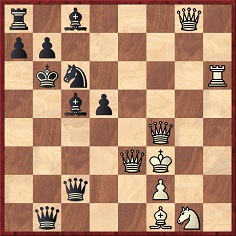
Edward Winter
Column 63 on page 27 of The Chess Beat by Larry Evans (Oxford, 1982) discusses the spurious game Alekhine-Grigoriev ‘Moscow, 1915’, given by Alekhine in his first collection of best games, but now known to be more invention than reality. Evans writes that ‘The first 11 moves did take place but the rest was a total fabrication’. What Alekhine wanted to show off was the five queens position and the quiet winning move 24 Rh6. Yet Evans says that Black could have drawn anyway by ...

24...Bg4+ 25 Qgxg4 Bxe3 26 Qb4+ (Or 26 Qxe3+ Qc5) 26...Qxb4 27 Qxb4+ Kc7 28 Qd6+ Kb6 29 Qb4+ and White has no more than perpetual check.
Do readers have any more information about the circumstances of this ‘game’. We recall that the late D.J. Morgan once told us that in any case Alekhine had been Black.
(326)
The Quotes and Queries column in the February 1983 BCM takes up this question. Moreover, C.D. Robinson (Toronto, Canada) sends us a few more facts:
‘Dr Buschke exposed this “game” as a fabrication in 1950-51 in his Chess Life series “Alekhine’s early chess career”. Kotov came to the same conclusion in 1957 (see Krabbé’s “On mass suggestion”, Chess Life & Review, 1977, page 480). Despite this, Kotov includes the “game” in his biography of Alekhine as “Alekhine-N.N., Moscow 1915”. According to M.V. Anderson (BCM 1958, page 133) the “game” originated in du Mont’s Elements of Chess in 1925. Moreover, du Mont and M.E. Goldstein were then engaged in translating the French MS of My Best Games of Chess 1908-23, which was published in 1927. “Alekhine’s MS was in appalling writing, and there was no collaboration between Alekhine and his two translators”, says Anderson. “Goldstein told me ... ‘We found (the score) among his papers and had no reason to challenge it.’”’
Mr Robinson concludes: ‘It is clear that Alekhine’s text includes both suggestio falsi and suppressio veri.’
It seems reasonable to assume that Alekhine was so taken with the quiet rook move that he simply tried to pull the wool over the chess world’s eyes. There is much irony and even pathos in the fact that it has subsequently been proved that the rook move does not win at all.
(387)
Chess Curiosities by Tim Krabbé (George Allen & Unwin) has themes ranging from castling to Loman’s Move and the Saavedra Manoeuvre. All are examined in impressive depth; it is a safe bet that Krabbé is the only author ever to have devoted ten pages to a discussion of ‘Alekhine’s five queens game’.
(1094)
On page 65 of Chess Curiosities Tim Krabbé states that ‘there is only one uncontested five queen game on record’, Tresling-Benima, Winschoten, 1896. On page 8 of Chess: The Complete Self-Tutor Edward Lasker refers to a game with five queens ‘played in the international tournament of Karlsbad in 1911’ although ‘the fifth queen came off directly after promotion’. We do not see any such game in the tournament book, the closest being Burn-Chajes (four queens at one time, an exchange of one pair, and a fifth one later).
(1217)
As reported in C.N. 1395, N.I. Grekov mistakenly claimed that the Burn-Chajes game had ‘five queens on the board at the same time’ (CHESS, 14 October 1937, page 56).
C.N. 751 pointed out that pages 77-80 of the Dresden, 1892 tournament book featured a remarkable game Albin-von Bardeleben in which six queens appear (not simultaneously). See Queen Endings.
Headed ‘The Mythical “Five Queens’ Game”’, an item by D.J. Morgan on page 130 of the May 1956 BCM began:
‘The ghost has been truly laid ...’
He was reporting on a series of articles by Albrecht Buschke in Chess Life in 1950 which had demonstrated that the ‘five queens’ play given by Alekhine in a note to Game 26 in his first volume of Best Games was spurious.
C.N.s 326 and 387 touched on the matter, and since then it has been analysed in detail by Tim Krabbé, on pages 54-64 of Chess Curiosities (London, 1985) and on his website. The case is regularly cited as an example of Alekhine’s ‘dishonesty’.
How is it possible that, even today, there are authors who state that Alekhine won such a game? The latest instance noted by us is on page 381 of Best Play by Alexander Shashin (Newton Highlands, 2013).
Tresling v Benima, Winschoten, 1896, a famous five-queens game, was given on pages 177-178 of The Chess Companion by Irving Chernev (New York, 1968). The item was reproduced from ‘Chernev’s Chess Corner’ on the inside front cover of Chess Review, February 1950:
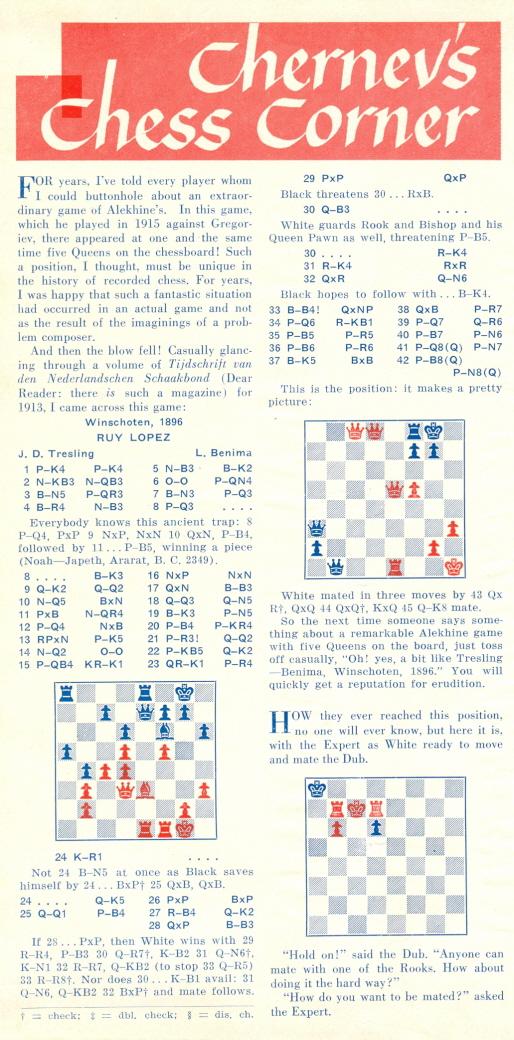
The game was also discussed in D.J. Morgan’s Quotes and Queries column on page 105 of the April 1962 BCM:
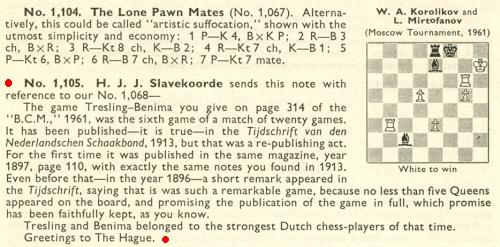
Can a reader send us copies of what was published in the nineteenth-century volumes of the Dutch magazine? For now, we can give only the game’s appearance on pages 172-173 of the July 1913 Tijdschrift van den Nederlandschen Schaakbond:
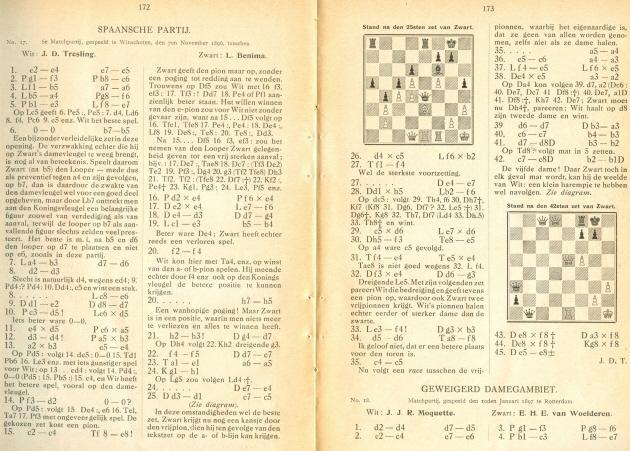
Below is Tresling’s obituary on page 115 of the April 1939 Tijdschrift van den Koninklijken Nederlandschen Schaakbond:
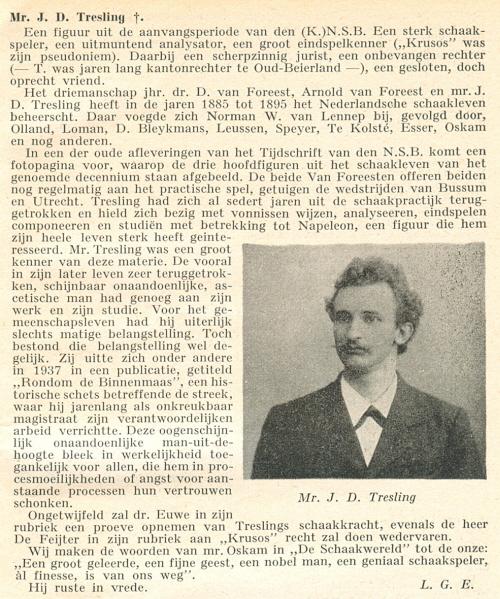
(7107)
Peter de Jong (De Meern, the Netherlands) has supplied the items requested. Firstly, page 268 of the December 1896 Tijdschrift van den Nederlandschen Schaakbond:
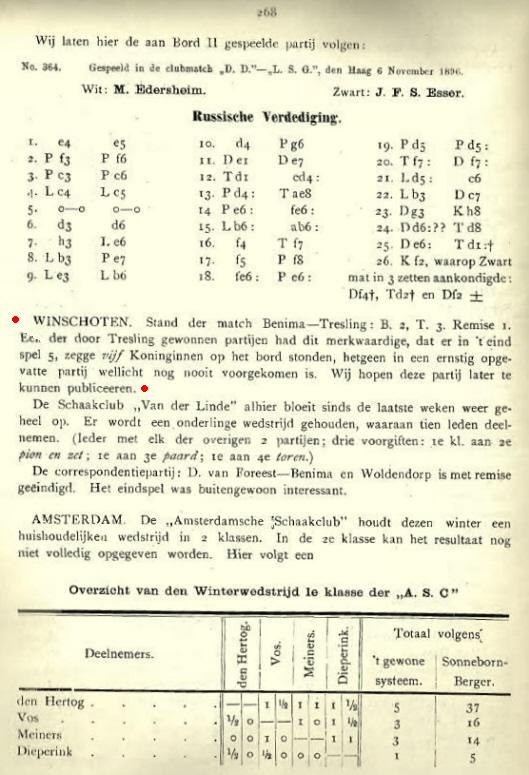
Pages 110-112 of the May 1897 issue of the Dutch periodical:
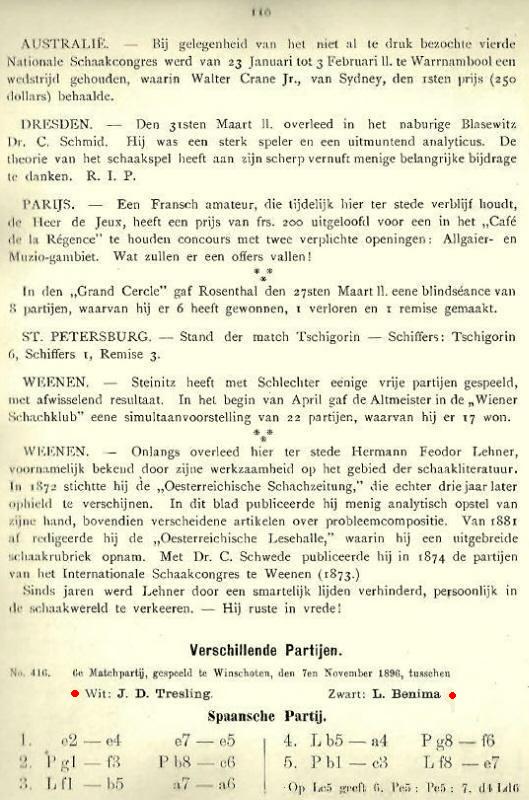
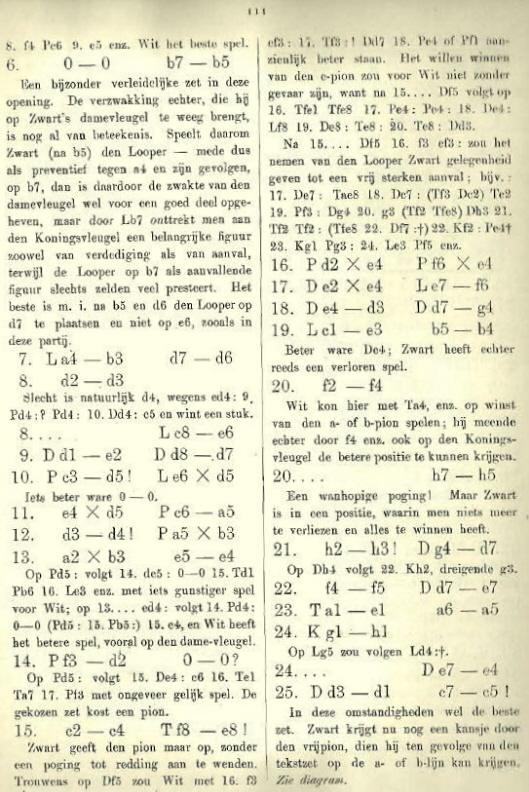
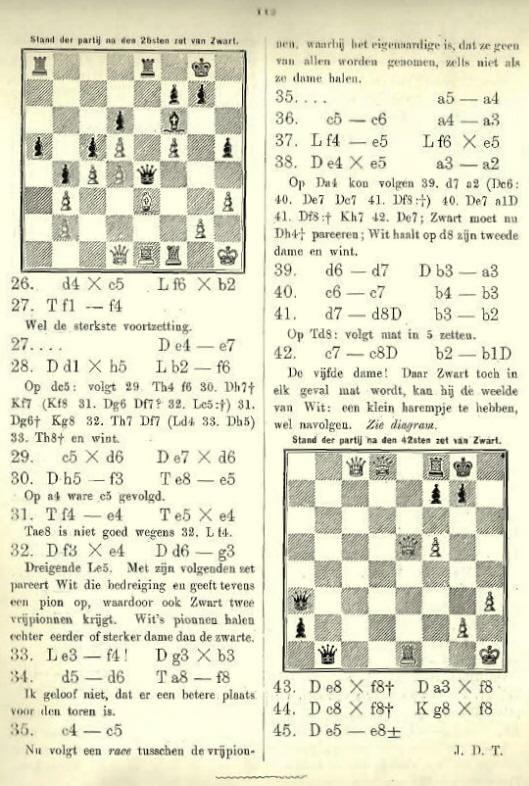
(7111)
To the Chess Notes main page.
To the Archives for other feature articles.
Copyright: Edward Winter. All rights reserved.